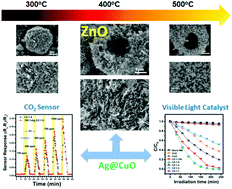当前位置:
X-MOL 学术
›
Inorg. Chem. Front.
›
论文详情
Our official English website, www.x-mol.net, welcomes your
feedback! (Note: you will need to create a separate account there.)
Modulating interleaved ZnO assembly with CuO nanoleaves for multifunctional performance: perdurable CO2 gas sensor and visible light catalyst
Inorganic Chemistry Frontiers ( IF 6.1 ) Pub Date : 2017-09-12 00:00:00 , DOI: 10.1039/c7qi00474e Shravanti Joshi 1, 2, 3, 4, 5 , Ram Kumar C. B. 1, 2, 3, 4, 5 , Lathe A. Jones 1, 2, 3, 4, 5 , Edwin L. H. Mayes 5, 6, 7, 8 , Samuel J. Ippolito 1, 2, 3, 4, 5 , Manorama V. Sunkara 9, 10, 11, 12, 13
Inorganic Chemistry Frontiers ( IF 6.1 ) Pub Date : 2017-09-12 00:00:00 , DOI: 10.1039/c7qi00474e Shravanti Joshi 1, 2, 3, 4, 5 , Ram Kumar C. B. 1, 2, 3, 4, 5 , Lathe A. Jones 1, 2, 3, 4, 5 , Edwin L. H. Mayes 5, 6, 7, 8 , Samuel J. Ippolito 1, 2, 3, 4, 5 , Manorama V. Sunkara 9, 10, 11, 12, 13
Affiliation

|
Herein, we report the preparation of well characterized hierarchical CuO/ZnO heterostructures and demonstrate the versatility of this composite as a CO2 gas sensor and a visible light catalyst for methylene blue (MB) degradation. 3D hierarchical ZnO spheres were decorated with CuO nanoleaves to form the interleaved p-CuO/n-ZnO hetero-surfaces. Subsequently, silver (Ag) functionalized composites were tested for their sensitivity and selectivity towards CO2 gas as a core application. The nanostructured Ag@CuO/ZnO composite demonstrated an improved sensor response of 34% at 320 °C with response/recovery times of 76 and 265 s compared to the CuO/ZnO composite and control samples. Additionally, the Ag@CuO/ZnO composite displayed excellent recovery (97%), repeatability (96%), accuracy (86%), and lower baseline drifts with a co-efficient of variation (COV) of 4.5% measured over an extended period of 40 days towards 1000 ppm CO2 gas for 10 individually tested sensors. In a parallel application as a photocatalyst, the CuO/ZnO composite was observed to degrade 98% methylene blue in 180 min with the first order rate constant (κapp) found to be 6- and 75-fold greater, respectively, when compared to the ZnO and CuO samples under visible light irradiation. The gas sensing mechanism substantiated from in situ diffuse reflectance infra-red Fourier transform spectroscopy (DRIFTS) confirmed the formation of copper carbonate in the presence of CO2. Interleaved assembly ensured the high mobility of electron–hole pairs with concerted efforts from a high effective surface area, multi-interleaved p/n nano-interfaces and the catalytic role of Ag. The confluence of these factors resulted in an improved CO2 sensor response and photocatalytic performance.
中文翻译:

使用CuO纳米叶调节交错式ZnO组件以实现多功能性能:持久的CO 2气体传感器和可见光催化剂
本文中,我们报告了表征良好的分层CuO / ZnO异质结构的制备,并证明了该复合材料作为CO 2气体传感器和亚甲基蓝(MB)降解的可见光催化剂的多功能性。用CuO纳米叶装饰3D分层ZnO球体,以形成交错的p-CuO / n-ZnO异质表面。随后,测试了银(Ag)功能化的复合材料对CO 2的敏感性和选择性天然气为核心应用。与CuO / ZnO复合材料和对照样品相比,纳米结构的Ag @ CuO / ZnO复合材料在320°C时具有34%的改善的传感器响应,响应/恢复时间分别为76和265 s。此外,Ag @ CuO / ZnO复合材料具有优异的回收率(97%),可重复性(96%),准确性(86%)和较低的基线漂移,在长期使用中测得的变异系数(COV)为4.5%对于10个单独测试的传感器,在1000 ppm CO 2气体下的测试时间为40天。在并行应用作为光催化剂,所观察到的的CuO / ZnO复合物以降解98%亚甲蓝在180分钟与一级速率常数(κ应用)与可见光照射下的ZnO和CuO样品相比,分别增加了6倍和75倍。由原位漫反射红外红外傅里叶变换光谱(DRIFTS)证实的气体传感机制证实了在存在CO 2的情况下碳酸铜的形成。交错的组装通过高有效表面积,多重交错的p / n纳米界面和Ag的催化作用共同努力,确保了电子-空穴对的高迁移率。这些因素的融合导致改善的CO 2传感器响应和光催化性能。
更新日期:2017-11-08
中文翻译:

使用CuO纳米叶调节交错式ZnO组件以实现多功能性能:持久的CO 2气体传感器和可见光催化剂
本文中,我们报告了表征良好的分层CuO / ZnO异质结构的制备,并证明了该复合材料作为CO 2气体传感器和亚甲基蓝(MB)降解的可见光催化剂的多功能性。用CuO纳米叶装饰3D分层ZnO球体,以形成交错的p-CuO / n-ZnO异质表面。随后,测试了银(Ag)功能化的复合材料对CO 2的敏感性和选择性天然气为核心应用。与CuO / ZnO复合材料和对照样品相比,纳米结构的Ag @ CuO / ZnO复合材料在320°C时具有34%的改善的传感器响应,响应/恢复时间分别为76和265 s。此外,Ag @ CuO / ZnO复合材料具有优异的回收率(97%),可重复性(96%),准确性(86%)和较低的基线漂移,在长期使用中测得的变异系数(COV)为4.5%对于10个单独测试的传感器,在1000 ppm CO 2气体下的测试时间为40天。在并行应用作为光催化剂,所观察到的的CuO / ZnO复合物以降解98%亚甲蓝在180分钟与一级速率常数(κ应用)与可见光照射下的ZnO和CuO样品相比,分别增加了6倍和75倍。由原位漫反射红外红外傅里叶变换光谱(DRIFTS)证实的气体传感机制证实了在存在CO 2的情况下碳酸铜的形成。交错的组装通过高有效表面积,多重交错的p / n纳米界面和Ag的催化作用共同努力,确保了电子-空穴对的高迁移率。这些因素的融合导致改善的CO 2传感器响应和光催化性能。











































 京公网安备 11010802027423号
京公网安备 11010802027423号